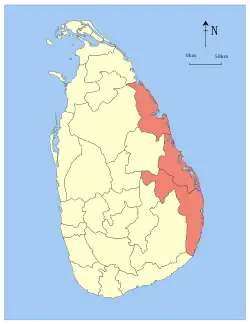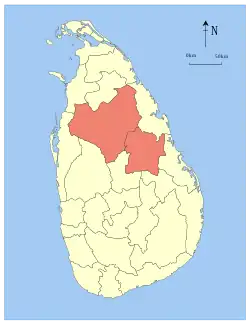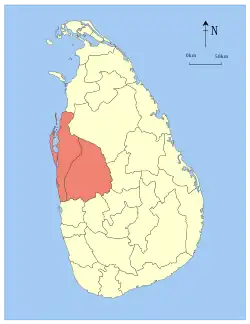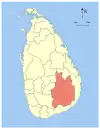Sabaragamuwa Province
The Sabaragamuwa Province (Sinhala: සබරගමුව පළාත Sabaragamuwa Paḷāta, Tamil: சபரகமுவ மாகாணம் Sabaragamuwa Mākāṇam) is one of the nine provinces of Sri Lanka, the first level administrative division of the country. The provinces have existed since the 19th century but did not have any legal status until 1987 when the 13th Amendment to the Constitution of Sri Lanka established provincial councils.[5][6] The Sabaragamuwa Province contains two districts: Ratnapura and Kegalle. It is named after its former indigenous inhabitants, namely the Sabara, an indic term for hunter-gatherer tribes, a term seldom used in ancient Sri Lanka. Sabaragamuwa University is in Belihuloya.
Sabaragamuwa Province
සබරගමුව පළාත சப்ரகமுவ மாகாணம் | |
|---|---|
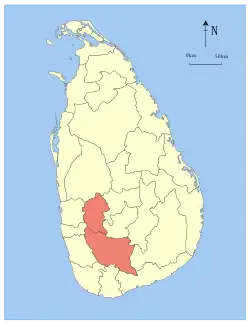 Location within Sri Lanka | |
| Coordinates: 6°40′N 80°24′E | |
| Country | Sri Lanka |
| Created | 1889 |
| Admitted | 14 November 1987 |
| Capital | Ratnapura |
| Largest city | Ratnapura |
| Districts | |
| Government | |
| • Type | Provincial council |
| • Body | Sabaragamuwa Provincial Council |
| • Governor | Navin Dissanayake |
| Area | |
| • Total | 4,968 km2 (1,918 sq mi) |
| • Rank | 8th (7.46% of total area) |
| Population (2011 census) | |
| • Total | 1,918,880 |
| • Rank | 5th (9.63% of total pop.) |
| • Density | 390/km2 (1,000/sq mi) |
| Ethnicity (2012 census)[1] | |
| • Sinhalese | 1,666,180 (86.4%) |
| • Indian Tamil | 105,872 (5.49%) |
| • Sri Lankan Moors | 82,343 (4.27%) |
| • Sri Lankan Tamil | 72,298 (3.75%) |
| • Other | 1,962 (0.09%) |
| Religion (2012 census)[2] | |
| • Buddhist | 1,653,381 (85.73%) |
| • Hindu | 156,312 (8.1%) |
| • Muslim | 85,610 (4.44%) |
| • Christian | 33,219 (1.72%) |
| • Other/None | 133 (0.006%) |
| Time zone | UTC+05:30 (Sri Lanka) |
| ISO 3166 code | LK-9 |
| Vehicle registration | SG |
| Official Languages | Sinhala, Tamil |
| Flower | Vesak flower (Dendrobium Maccarthiae) |
| Literacy (2012) | 94.8% |
| Computer literacy (2020) | 32% |
| Website | www |
Districts
Sabaragamuwa is divided into 2 districts:
- Kegalle District 1,693 km2 (654 sq mi)
- Ratnapura District 3,275 km2 (1,264 sq mi)
Municipal Council
Urban Council
Other Towns
- Bulathkohupitiya
- Belihuloya
- Eheliyagoda
- Kalawana
- Kuruwita
- Mawanella
- Aranayaka
- Rakwana
- Imbulpe
- Deraniyagala
- Ambepussa
- Rambukkana
- Kitulgala
- Panamure
- Godakawela
- Yatiyanthota
- Karawanalla
- Ruwanwella
- Aguruwalla
- Dehiowita
Demographics
Ethnic groups
Ethnic groups in Sabaragamuwa province (2012 census)[7]
Sinhalese are the majority of Sabaragamuwa province which makes 86.4% of the province. Sinhalese who makes the majority of the Sabaragamuwa province as well as the majority of the country speak Sinhala language which is an Indo-Aryan language.
Indian Tamils is 5.49% of the province. Indian Tamils were brought to Sri Lanka by Britishers as workers in tea plantations and rubber plantations.
Moors make 4.27% of the province. The origins of the Moors refer to Arab traders who landed on the island in the 8th-9th centuries.Also many Moors can speak Sinhala language as their mother tongue. Moors speak Tamil language as their second language.
Sri Lankan Tamils are 3.75% of the Sabaragamuwa province. Sri Lankan Tamils speak Tamil language which is their mother tongue.
Religion
Religion in Sabaragamuwa province (2012 census)[8]
Buddhism is 85.7% in Sabaragamuwa province. Buddhism is followed by majority Sinhalese. Also a small Tamil population follow Buddhism. Hinduism is 8.1% in Sabaragamuwa province. Indian Tamils and Sri Lankan Tamils follow Hinduism. Islam is 4.43% which is followed by Moors. And Christianity make 1.72% of the province.[9]
| Religion | Census 1981[12] | Census 2001[13] | Census 2012[14] | |||
|---|---|---|---|---|---|---|
| Population | % | Population | % | Population | % | |
| Buddhism | 1,259,396 | 84.98% | 1,547,769 | 85.77% | 1,653,381 | 85.73% |
| Hinduism | 146,010 | 9.86% | 148,400 | 8.2% | 156,312 | 8.1% |
| Islam | 51,248 | 3.46% | 73,576 | 4% | 85,610 | 4.44% |
| Christianity | 24,892 | 1.67% | 30,994 | 2% | 33,219 | 1.72% |
| Others/None | 485 | 0.03% | 592 | 0.03% | 133 | 0.006% |
| Total | 1,482,031 | 100% | 1,801,331 | 100% | 1,928,655 | 100% |
References
- "A2 : Population by ethnic group according to districts, 2012". Census of Population & Housing, 2011. Department of Census & Statistics, Sri Lanka.
- "A3 : Population by religion according to districts, 2012". Census of Population & Housing, 2011. Department of Census & Statistics, Sri Lanka.
- "Sri Lanka.pdf" (PDF). Department of Census & Statistics, Sri Lanka.
- "Computer Literacy Statistics-2020 (Annual)" (PDF). Department of Census and Statistics, Sri Lanka.
- "Provinces of Sri Lanka". Statoids.
- "Provincial Councils". Government of Sri Lanka. Archived from the original on 2009-07-07.
- "South Asia: Sri Lanka". CIA. 22 September 2021.
- "A3 : Population by religion according to districts, 2012". Census of Population & Housing, 2011. Department of Census & Statistics, Sri Lanka.
- "A3 : Population by religion according to districts, 2012". Census of Population & Housing, 2011. Department of Census & Statistics, Sri Lanka.
- "Population by religion and district, census 1981,2001,2012". Department of Census & Statistics, Sri Lanka.
- "Census of Population and Housing of Sri Lanka, 2012 - Table A4: Population by district, religion and sex" (PDF). Department of Census & Statistics, Sri Lanka. Archived (PDF) from the original on 2014-12-29.
- "Population by religion and district, census 1981,2001,2012". Department of Census & Statistics, Sri Lanka.
- "Population by religion and district, census 1981,2001,2012". Department of Census & Statistics, Sri Lanka.
- "Census of Population and Housing of Sri Lanka, 2012 - Table A4: Population by district, religion and sex" (PDF). Department of Census & Statistics, Sri Lanka. Archived (PDF) from the original on 2014-12-29.
.PNG.webp)

